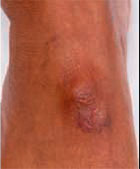A Guide to Common Skin Conditions: Essential Knowledge for Beauticians
As a beautician, understanding common skin conditions is an essential component of delivering safe and effective services to clients. Skin issues are not only aesthetic concerns, but they also may reflect underlying health problems, which is why it is crucial for beauty professionals to recognize different types of skin lesions and inflammation and know when to refer clients to medical professionals.

Skin Conditions
Recognizing and Responding to Skin Inflammation
Inflammation is one of the most visible signs of a skin issue. It may manifest as redness and swelling and can occur for various reasons. Short-term inflammation, such as that caused by a sunburn, typically resolves without significant long-term effects. However, long-term or chronic inflammation can lead to permanent tissue damage and should be a cause for concern.
If a client presents with prolonged skin inflammation, the appropriate course of action is to refer them to a dermatologist. Dermatologists can determine the cause of the inflammation and discuss potential treatment options. It’s vital to remember that beauticians should not attempt to treat chronic inflammation themselves and should refrain from providing services to clients with inflamed skin disorders—whether infectious or not—without a physician’s note permitting the client to receive such services.
Understanding Primary and Secondary Skin Lesions
Skin lesions are abnormalities in the skin’s texture, color, or appearance. They can take many forms and be classified as primary or secondary lesions.
Primary lesions are changes in the skin’s color or texture that appear in the initial stages of a skin condition. These lesions can be flat or raised above the skin’s surface and are often filled with fluid. Primary lesions can vary significantly in size, color, and the layers of skin affected. Recognizing these lesions can help identify skin conditions in their early stages, allowing for timely intervention and treatment.
Primary Lesions | ||
Primary lesion | Description | Examples |
Bulla  | Large blister containing a watery fluid; similar to a vesicle; requires medical referral | Contact dermatitis, large second-degree burns, bullous impetigo, pemphigus |
Cyst and Tubercle 
 | Closed, irregularly developed sac that contains pus, semifluid, or morbid matter, above or below the skin; a cyst can be drained of fluid but a tubercle cannot; the latter requires medical referral | Cyst — severe acne |
Macule  | Flat spot or discoloration on the skin | Freckle or “age spot” |
Nodule  | Solid bump larger than 0.4 inch (1 centimeter) that is easily felt; requires medical referral | Swollen lymph nodes, rheumatoid nodules |
Papule  | Small skin elevation that contains no fluid but may develop pus | Acne, warts, elevated nevi |
Pustule  | Raised, inflamed, papule with a white or yellow center containing pus in the top of the lesion | Acne, impetigo, folliculitis |
Tumor  | Any type of irregular mass varying in size, shape, and color; not always cancer; requires medical referral | Cancer |
Vesicle  | Small blister or sac containing clear fluid, lying within or just beneath the epidermis; requires medical referral if cause is unknown or untreatable with over-the-counter products | Poison ivy, poison oak |
Wheal  | Itchy, swollen lesion caused by a blow, scratch, insect bite, urticaria (skin allergy), or nettle sting; typically resolves on its own, but refer to physician if condition lasts more than three days | Hives, mosquito bites |
Primary Lesions
Secondary lesions, on the other hand, involve changes in the skin’s surface due to the progression of a skin condition. These changes can involve the accumulation of material on the skin, such as crusts or scabs, or depressions in the skin surface, such as ulcers. Secondary lesions often indicate a more advanced or chronic skin condition, which may require medical intervention.
Secondary Lesions | ||
Secondary lesion | Description | Examples |
Fissure  | Crack in the skin that penetrates the dermis | Severely cracked and/or chapped hands, lips, or feet |
Keloid   | Thick scar resulting from excessive growth of fibrous tissue; keloids will form along any scar for people susceptible to them | Thick, raised scar |
Scale   | Thin, dry, or oily plate of epidermal flakes | Excessive dandruff, psoriasis |
Scar or cicatrix  | Slightly raised or depressed skin area formed as a result of the healing process related to an injury or lesion | Postoperative repair |
Ulcer   | Open skin lesion or mucous membrane of the body; accompanied by loss of skin depth and possibly weeping of fluids or pus; requires medical referral, particularly in clients with underlying medical conditions such as diabetes | Chicken pox, herpes |
Crust  | Dead cells that form over a wound or blemish while healing; accumulation of sebum and pus, sometimes mixed with epidermal cells | Scab, sore |
Excoriation  | Skin sore or abrasion produced by scratching or scraping | Nail cuticle damage from nail biting |
Secondary Lesions
The Role of the Beautician in Managing Skin Conditions
While beauticians are not medical professionals, they are often in a unique position to notice changes in their clients’ skin that may go unnoticed otherwise. By recognizing common skin conditions and knowing when to refer clients to dermatologists, beauticians can play a critical role in their clients’ overall skin health.
However, it’s crucial to note that while beauticians can identify potential skin conditions and suggest that clients seek medical advice, they should not attempt to diagnose or treat these conditions themselves. Always operate within the scope of your practice and seek professional medical advice when necessary.
Understanding and recognizing common skin conditions is a vital part of any beautician’s training and practice. This knowledge ensures that they can provide the best possible service to their clients while maintaining a safe and healthy salon environment.






